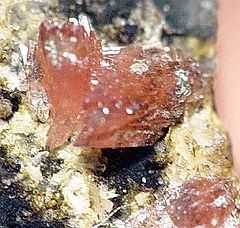Sarkinite
| Sarkinite | |
|---|---|
 | |
| General | |
| Category | Arsenate minerals |
| Formula (repeating unit) | Mn2(AsO4)(OH)[1] |
| Strunz classification | 8.BB.15[1] |
| Dana classification | 41.6.3.3[1] |
| Crystal symmetry | Space group: P21/a[2] |
| Unit cell |
a=12.7795(13) Å b=13.6127(14) Å c=10.2188(11) Å β = 108.834(2)° Z=16[1] |
| Identification | |
| Color | Red to yellow[1] |
| Crystal habit | Tabular[3] or granular[1] |
| Crystal system | Monoclinic |
| Cleavage | Distinct on {100}[1] |
| Fracture | Irregular/Uneven, Conchoidal[1] |
| Mohs scale hardness | 4–5[1] |
| Luster | Greasy[1] |
| Streak | Red to yellow[1] |
| Diaphaneity | Semitransparent[2] |
| Density | 4.08 to 4.18 g/cm3 (measured)[1] |
| Optical properties | Biaxial (-)[1] |
| Refractive index | nα=1.793, nβ=1.807, nγ=1.809[1] |
| Birefringence | δ = 0.016[1] |
| Pleochroism | Weak[1] |
| 2V angle | 83° (measured)[1] |
| Dispersion | r > v or r < v[1] |
| Absorption spectra | X > Z > Y[1] |
| Solubility | Readily soluble in dilute acids[1] |
Sarkinite, synonymous with chondrarsenite and polyarsenite, is a mineral with formula Mn2(AsO4)(OH). The mineral is named for the Greek word σάρκιυος, meaning made of flesh, for its red color and greasy luster. The mineral was first noted in Sweden in 1865 as chondrarsenite, though not identified as Sarkinite until 1885.
Description
Sarkinite is red to yellow in color. It occurs as thick tabular crystals, short prismatic crystals, or has a granular habit. Sarkinite sometimes aggregates into a roughly spherical shape. Sarkinite is a member of the Wagnerite Group.[1]
The mineral occurs in manganese-rich lenses in quartzitic chlorite schists, metamorphosed zinc ore bodies, and rarely in metamorphosed Fe–Mn ore bodies.[2]
Structure
Sarkinite is isostructural with triploidite and wolfeite[1] and is a dimorph of eveite.[4] The crystal structure consists of MnO4(OH)2 octahedra, MnO4(OH) trigonal bipyramids, and AsO4 tetrahedra.[5]
History
In 1885, two similar minerals were discovered in Sweden. Polyarsenite was found in Grythyttan and named by Igelström for its high arsenic content. Sarkinite was discovered in Pajsberg, Persberg, and named by A. Sjögren after the Greek word σάρκιυος, meaning made of flesh, in reference to the blood-red color and greasy luster. It was considered likely that the two minerals were identical.[6] A study in 1980 showed that polyarsenite and chondrarsenite, discovered in 1865, were in fact both sarkinite.[7]
Distribution
As of 2012, sarkinite has been found in Austria, France, Italy, Japan, Kazakhstan, Romania, Sweden, Switzerland, and the United States of America.[1]
Association
Sarkinite has been found in association with:[2]
Harstigen mine, Sweden
Sjö mine, Sweden
Ködnitz Valley, Austria
- Pyroxmangite, rhodochrosite, rhodonite, spessartine, tephroite, tiragalloite
Falotta mine, Switzerland
- Brandtite, braunite, grischunite, manganoan berzeliite, rhodochrosite, tilasite
Sterling Hill, New Jersey, USA
- Adamite, allactite, barite, brandtite, copper, euchroite, eveite, kraisslite, manganese oxides, parabrandtite, rhodochrosite, serpierite, willemite
References
- ↑ 1.0 1.1 1.2 1.3 1.4 1.5 1.6 1.7 1.8 1.9 1.10 1.11 1.12 1.13 1.14 1.15 1.16 1.17 1.18 1.19 1.20 1.21 1.22 "Sarkinite". Mindat. Retrieved May 28, 2012.
- ↑ 2.0 2.1 2.2 2.3 "Sarkinite" (PDF). Handbook of Mineralogy. Mineral Data Publishing. Retrieved May 30, 2012.
- ↑ "Sarkinite". Webmineral. Retrieved May 29, 2012.
- ↑ Halenius, p. 113.
- ↑ Dal Negro, p. 246.
- ↑ Smithsonian Institution (1886). Annual Report of the Board of Regents of the Smithsonian Institution Showing the Operations, Expenditures, and Condition of the Institution to July, 1885 (Report). Government Printing Office. p. 701. http://books.google.com/books?id=WLYAAAAAYAAJ&pg=PA701.
- ↑ Dunn, Pete J. (March 1980). "On the composition of some sarkinites" (PDF). Mineralogical Magazine 43 (329): 681. Retrieved May 29, 2012.
Bibliography
- Halenius, Ulf; Westlund, Erika (February 1998). "Manganese valency and the colour of the Mn2AsO4(OH) polymorphs eveite and sarkinite" (PDF). Mineralogical Magazine 62 (1): 113–119.
- Dal Negro, A.; Giuseppetti, G.; Pozas, J. M. Martin (1974). "The crystal structure of sarkinite, Mn2AsO4(OH)". Mineralogy and Petrology 21 (3–4): 246–260. Bibcode:1974TMPM...21..246D. doi:10.1007/BF01081034.
External links
![]() Media related to Sarkinite at Wikimedia Commons
Media related to Sarkinite at Wikimedia Commons